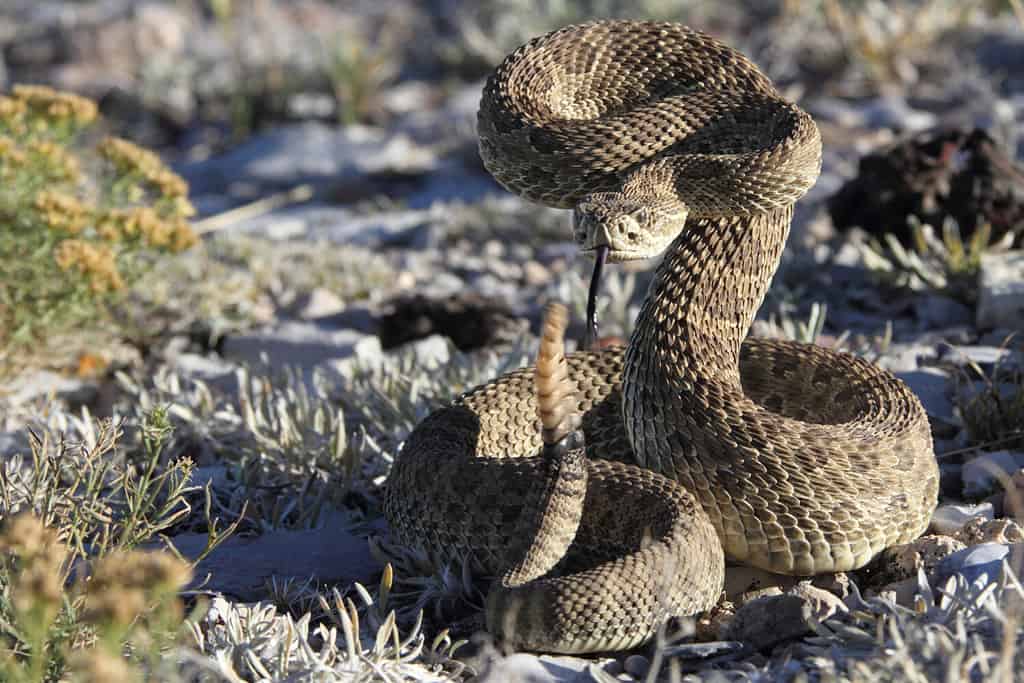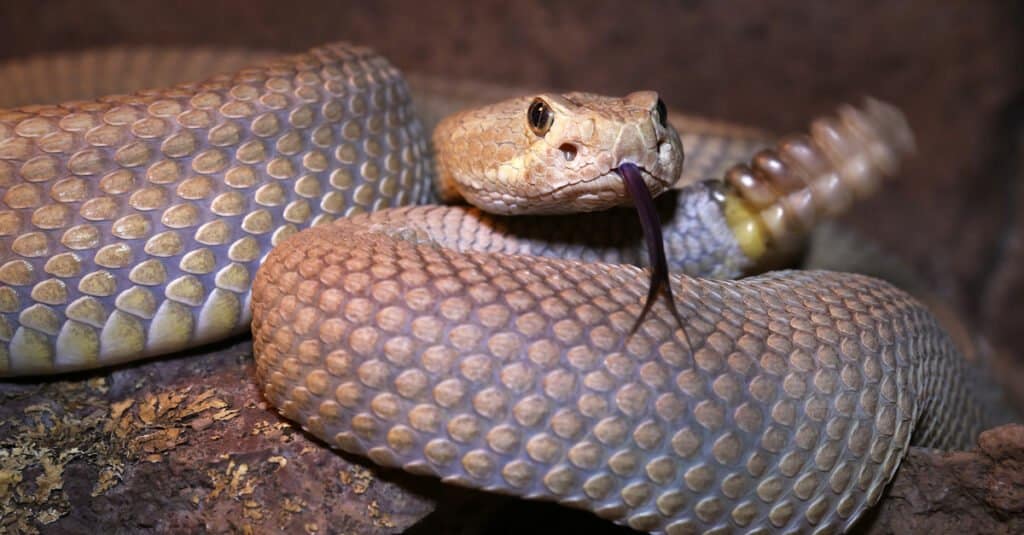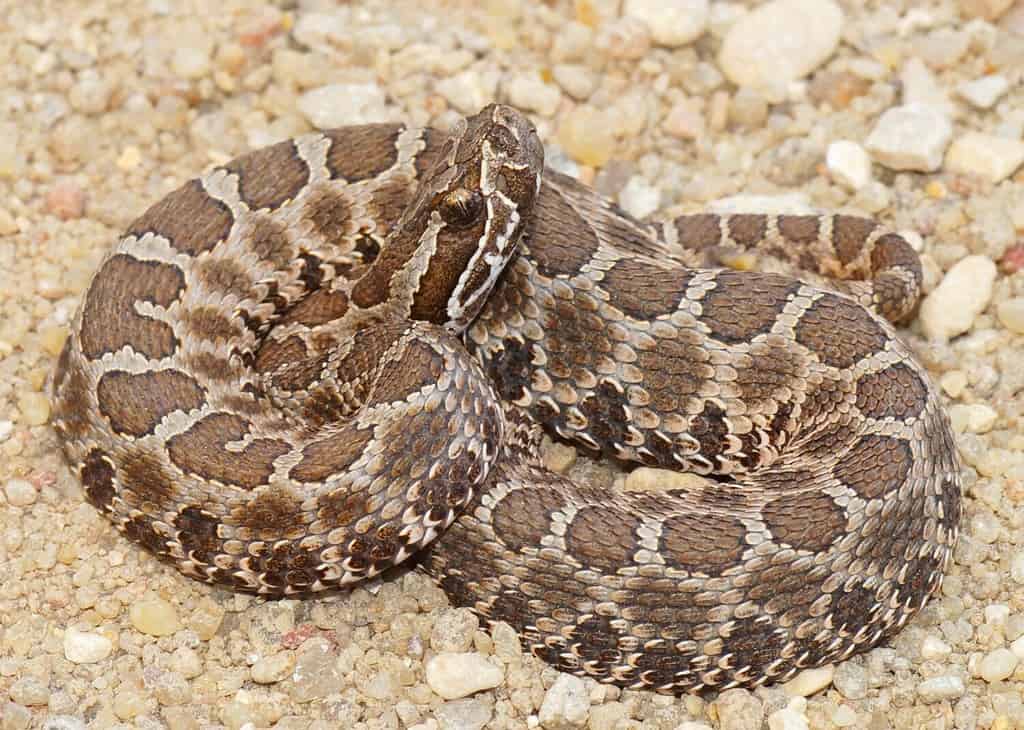
Rattlesnake poised to strike.
©Harris Motion Photo/Shutterstock.com
Snake bites in Arizona occur about 250 to 350 times a year. Since 2002, there have been five deaths in Arizona as a result of a snake bite. However, deaths from snake bites are rare, and snake bites can be avoided. The rattlesnake habitat is ideal in Arizona because of its hot, dry climate. No state has as many different species of rattlesnakes as Arizona.
People fear the largest rattlesnakes because they are intimidating. However, herpetologists report that the Arizona ridge-nosed rattlesnake (Crotalus willardi willardi) is a small snake found only in the south-central part of Arizona. Snakes, both tiny and juvenile, can be erratic and dangerous. A larger snake will usually rattle warningly before striking because it is easier to spot.
1. March 24, 2023
A rattlesnake bit Daniel Steininger, 77, while hiking on the Hawes Trail System. The snake reportedly rattled in warning, but Mr. Steininger could not react before the animal struck. Mr. Steininger suffered a left ankle bite from the snake. After his wife dialed 911, a BannerAir helicopter crew was dispatched by emergency services to take Mr. Steininger to the hospital.
The helicopter crew administered anti-venom while en route to the hospital. This was the first time that they had administered the anti-venom en route. Mr. Steininger recovered completely from his ordeal.
2. April 25, 2023
After being bitten by a rattlesnake at her house, a woman in Greenville called the emergency services. The snake bit the woman on the foot. She received emergency care and recovered completely from the ordeal. Officials say most snake bites occur in August and September, but they often see these incidents in April, when the snakes first come out of hibernation.
Snakebite chances increase as the temperatures outside warm up, thus bringing the snakes out. However, snakes will crawl under houses or move into houses when looking for a warm place to hibernate for the winter. A hibernating snake will bite if you startle or disturb them. Snakes bite to defend themselves, not as an act of meanness. Always check places where snakes might be hiding carefully before you bend over or move something they could be hiding under.
3. April 29, 2023
A rattlesnake hiding in a decorative planter bit an elderly woman in southern Arizona. Authorities captured the two- to three-foot-long snake and transported it to the hospital for identification. The woman informed medical personnel that she had not received any warning from the snake before its attack. Rattlesnakes usually rattle to warn, but this one did not.
After receiving anti-venom treatment, the woman was discharged from the hospital a few days later. She is going to recover fully.
4. May 2023
The most common locations for snake bites in Arizona are your home or yard. In Green Valley, a woman was bitten by a western diamondback rattlesnake as she made her way to her backyard fence. The woman was taken to a hospital in Tucson, where she recovered fully after obtaining emergency care.
Snake bites in Arizona require quick medical attention, and the victim can be hospitalized for several days or weeks after a bite. Elderly victims and young children are most likely to have severe reactions after a bite, and even after the victim is released from the hospital, they should be carefully monitored.
Why Snake Bites In Arizona Are So Scary

The Mojave rattlesnake is best known for its potent neurotoxic venom.
©Ryan M. Bolton/Shutterstock.com
The number one reason why snake bites in Arizona are so scary is because the state is home to 40 species of snakes, and 21 of them are venomous. The majority of the venomous snakes in Arizona are species of rattlesnakes. Everyone thinks that Texas has the largest snake population, while the state with the most venomous snakes in the southwest is Arizona. Texas and Arizona share one thing: the Mojave rattlesnake is the most venomous type of rattler in both states.
Rattlesnakes That Are Responsible for Snake bites in Arizona

Rattles are made from nested scales and break off constantly.
©Chase D’animulls/Shutterstock.com
- Arizona Black Rattlesnake
- Arizona Ridged-Nose Rattlesnake
- Banded Rock Rattlesnake
- Blacktail rattlesnake
- Desert Massasauga
- Great Basin Rattlesnake
- Mohave rattlesnake
- Prairie Rattlesnake
- Sidewinder
- Speckled rattlesnakes
- Tiger rattlesnake
- Twin-Spotted Rattlesnake
- Western Diamondback
How To Prevent Snake Bites In Arizona

The desert Massasauga rattlesnake is camouflaged by patterns and colors.
©Matt Jeppson/Shutterstock.com
The majority of snake bite incidents occur between 4:00 and 6:00 p.m. 52% of the reported occupational snakebites that occur in the United States happen in Arizona. Individuals who work in landscaping, construction, and snake removal occupations are likelier to have a snake bite related to their work.
Young men between the ages of 11 and 49 are bitten by snakes the most often. However, a snake can bite anyone, regardless of age or gender. Most snake bites can be avoided. The Mojave rattlesnake is the most venomous species of rattlesnake.
Snake Bite Prevention Strategies
- Stay on marked trails.
- Do not wander around after dark.
- Do not try to capture snakes. Do not tease or provoke a snake.
- Do not keep venomous snakes as pets.
- Check clothing, sleeping bags, and luggage carefully.
- If you see a snake on the trail, back away and give the animal ample room to flee.
- Install snake-proof fencing around your yard.
- Stay alert while watching the trail you are on.
- Do not run your hand under potted plants without looking for a snake.
- Do not hike while wearing headphones.
- Wear protective footwear that comes above your ankle.
- Don’t put your hands and feet in places you cannot see.
- Turn over logs and rocks using a shovel or long stick before placing your hands close to them.
What To Do If You Sustain A Snake Bite In Arizona
If a snake bites you, the first thing you must do is remain calm. When you get excited, your heart rate becomes elevated, which makes the snake venom move more quickly through your system. Do not try to catch the snake. Dial 911 and give the operator as much information as possible.
| Do | Do Not Do |
| Remain calm | Make a cut over the bite |
| Dial 911 | Apply a tourniquet |
| Keep the bite below the level of your heart. | Apply ice. |
| Remove any clothing that might restrict your blood flow. | Attempt to suck the venom with your mouth. |
| Keep the bitten area immobile to slow venom spread. | Run soapy water over the bite to clean it. |
| Try to remember the color and size of the snake. | Try to catch the snake. |
| Sit down and wait for help to arrive. | Drink alcohol. |
| Keep the victim as cool as possible. | Eat or drink anything containing caffeine. |
FAQs
After a rattlesnake bite, how long do you have to get medical attention?
Ideally, you will get medical attention within 30 minutes after receiving a snake bite. The effects of the venom will begin to be felt immediately, and as time passes, the effects will worsen. Two to three days after a bite, your organs will shut down if you have not received treatment.
Can doctors give you anti-venom if you do not know what type of snake bit you?
Knowing the type of snake that bit you is helpful; however, treatment of envenomation does not require the victim to know the exact species of snake that bit them.
How many people in the United States die as a result of snake bites each year?
Four to five people in the United States succumb to the venom of a snake bite or die of complications caused by receiving a snake bite each year.
The photo featured at the top of this post is © Kevin Wells Photography/Shutterstock.com
Discover the "Monster" Snake 5X Bigger than an Anaconda
Every day A-Z Animals sends out some of the most incredible facts in the world from our free newsletter. Want to discover the 10 most beautiful snakes in the world, a "snake island" where you're never more than 3 feet from danger, or a "monster" snake 5X larger than an anaconda? Then sign up right now and you'll start receiving our daily newsletter absolutely free.
Thank you for reading! Have some feedback for us? Contact the AZ Animals editorial team.







